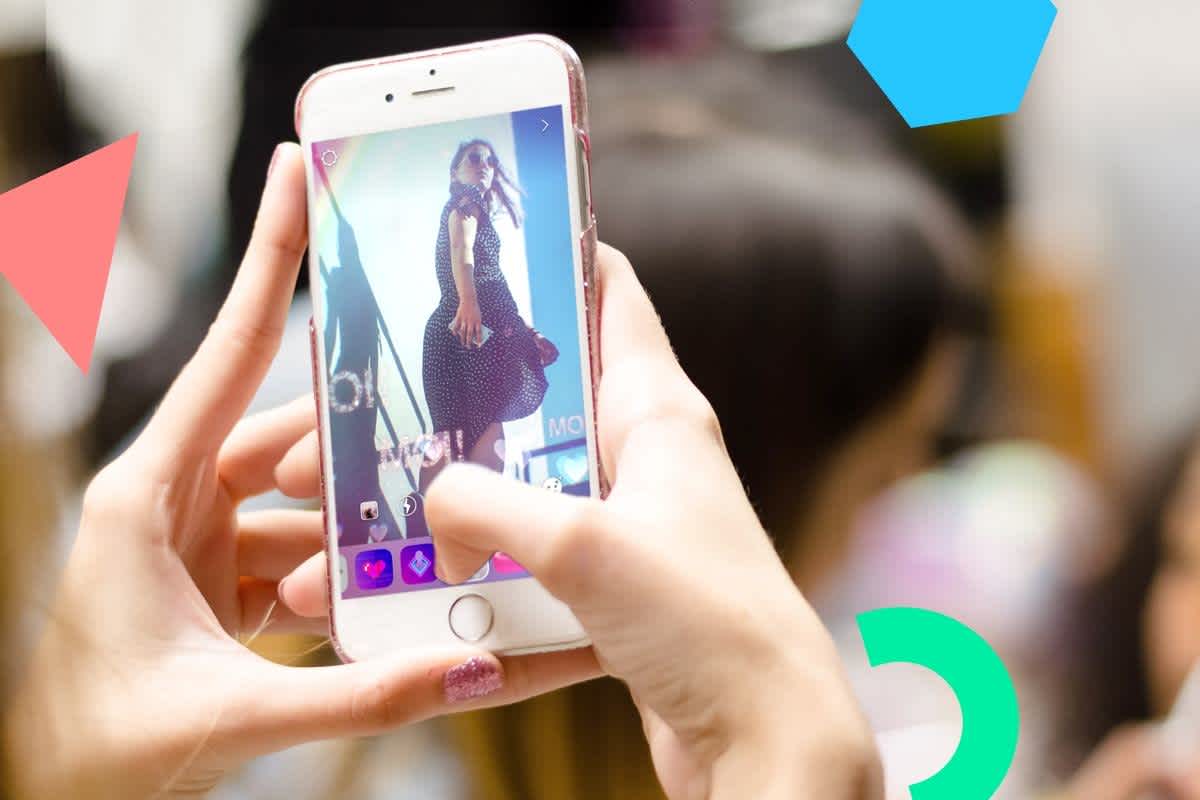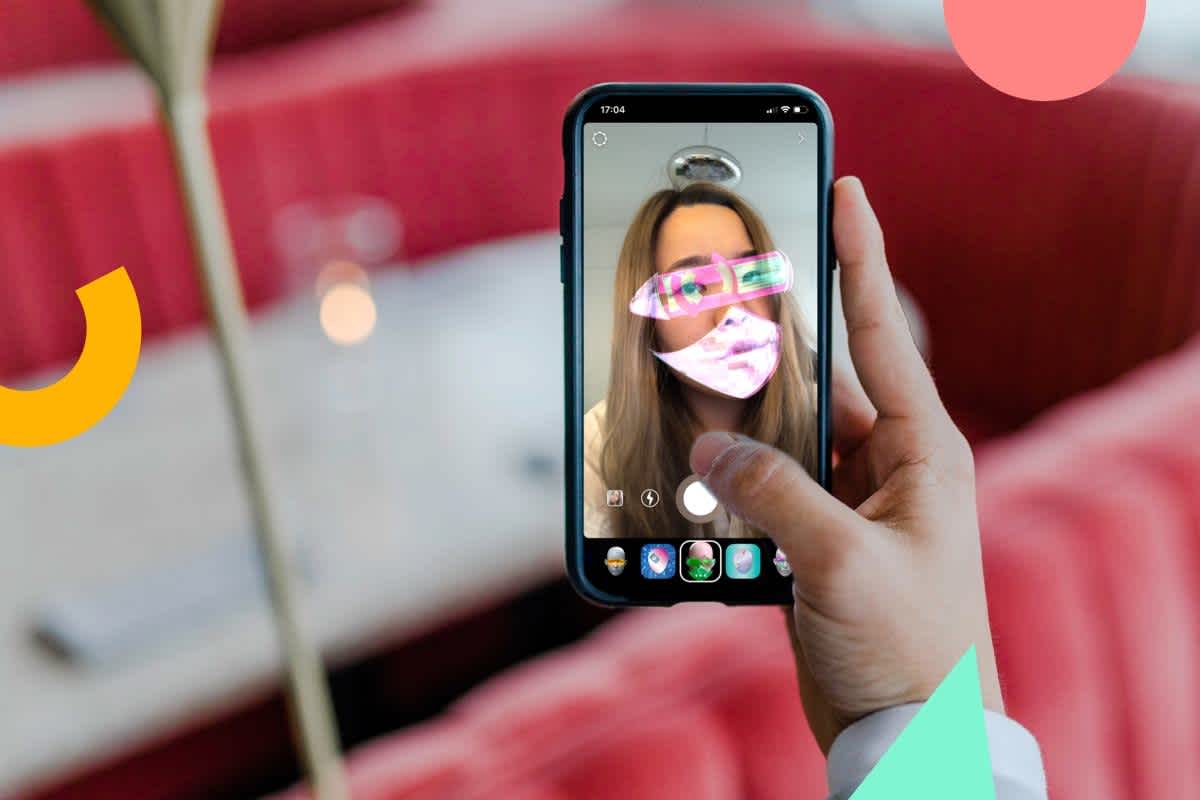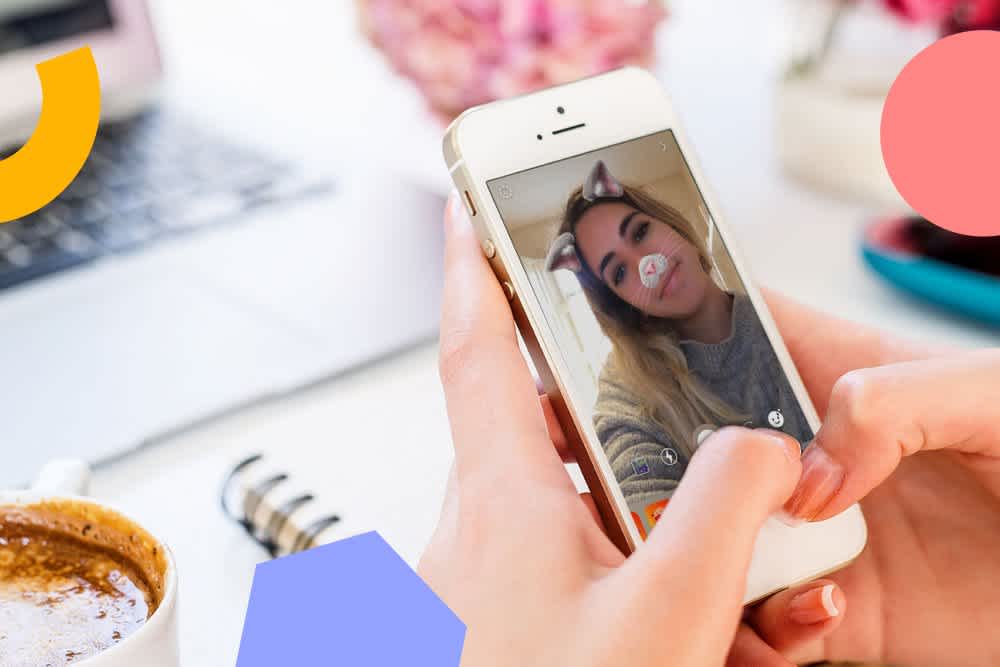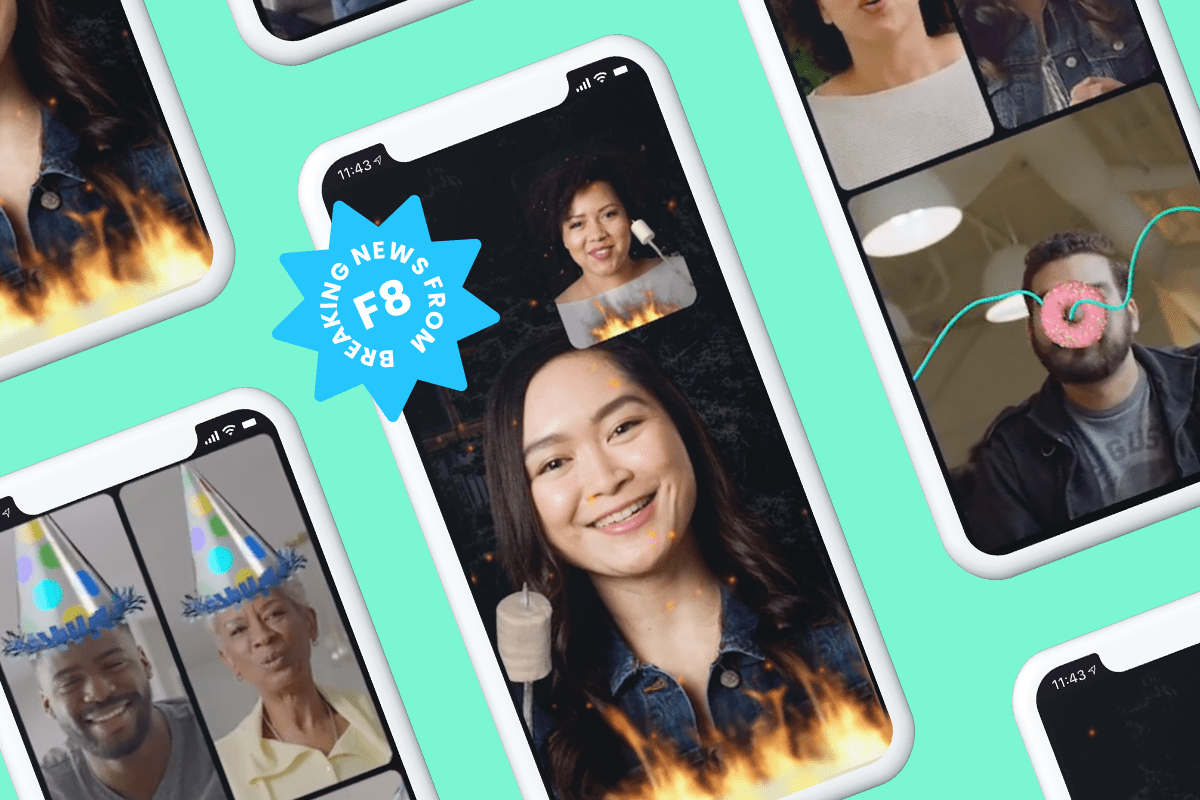Facebook’s Spark AR Studio allows anyone to create augmented reality filters and effects for Instagram Stories.
Augmented reality, or AR, may seem like a futuristic term that doesn’t apply to your everyday life, but did you know that 1 billion people have had a Spark AR experience in the last year? That’s a whole lot of people getting on board with AR and Instagram filters.
And it’s about to explode: starting August 2018, anyone can create and publish their own Spark AR effects for Instagram Stories!
Custom Instagram Stories filters are no longer limited to the Kylie Jenner’s and Nike’s of the world, giving artists and brands of every size the opportunity to create a viral moment on Instagram.
Keep reading to learn more about the future of Instagram and best practices for creating your own Spark AR effects for Instagram, including how AR filters work as a growth hack to getting more followers.
Note: In response to COVID-19, Facebook and Instagram are no longer accepting new AR filters for the foreseeable future. Creators can continue to use Spark AR Hub and submit their effects and updates to be reviewed at a later date.
What is Spark AR Studio?
Spark AR Studio is an augmented reality platform for Mac & Windows that allows you to somewhat easily create AR effects for mobile cameras. Think of it like Photoshop or Sketch, but for AR.
AR (short for “augmented reality”) isn’t a new technology — in fact, it’s been around since the 1960s! But it’s only in the last few years that AR technology has accelerated and spread across dozens of industries; today it can be found everywhere from Pokémon GO to Google Maps.
Social media is clearly riding the AR wave too, and a big part of this success is because of how hugely popular Instagram Stories is.
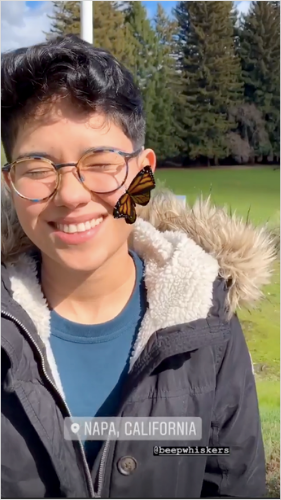
With over 500 million daily active users, an extremely user-friendly UI, and the millennial human desire to share fun, filtered selfies, Instagram is the perfect medium to spread AR to the masses.
But equally important was Facebook’s decision in 2017 to launch its own software for brands and designers to create customized AR effects.
While the Spark AR Studio platform has been open to everyone, if you wanted your custom AR effects to go live on Instagram, you had to be accepted as part of the closed beta program.
But that’s all changed now!
According to a Facebook announcement, anyone can now create and publish their own Spark AR effects on Instagram Stories!
This is a huge deal and an exciting opportunity for artists, brands, influencers, and everyday people to get creative and learn how to make their imagination a reality using AR.
AR on Instagram has enormous potential as a marketing tool (something we’ll discuss in just a minute), but it’s still massively underused.
Because of this, businesses have a lot to gain from jumping in early, learning the ropes, and finding creative ways to build and share their own branded AR experiences on Instagram Stories.
How Businesses Can Use Spark AR Effects for Instagram
There are many reasons why AR can be a powerful marketing tool for businesses — but one of the biggest has to do with freedom of creativity.
When it comes to AR, the world really is your oyster!
There are countless applications for the technology: cosmetics brands can use AR to let their followers virtually “try on” makeup, furniture brands can use AR to show what their products would look like in people’s homes, and fashion brands can use AR to create virtual fitting rooms, allowing people to try on shirts, sunglasses, or entire outfits to see how it fits their shape and style.
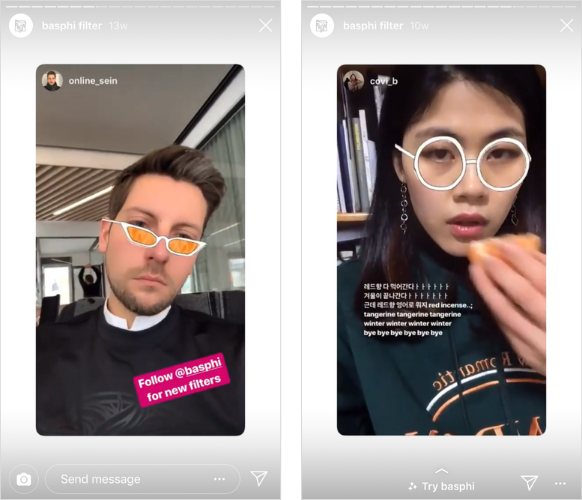
There’s also something to be said about the emotional value of AR. By creating these kinds of AR experiences where people can “try” products, businesses might have an easier time building a personalized connection with customers — which could also help drive more purchases!
Plus, Instagram is now baking this feature into the app! The platform is beta testing a new feature that will allow brands to add AR effects to their product pages.
With the new Spark AR integration, users will be able to virtually “try” products before making a purchase in the app.
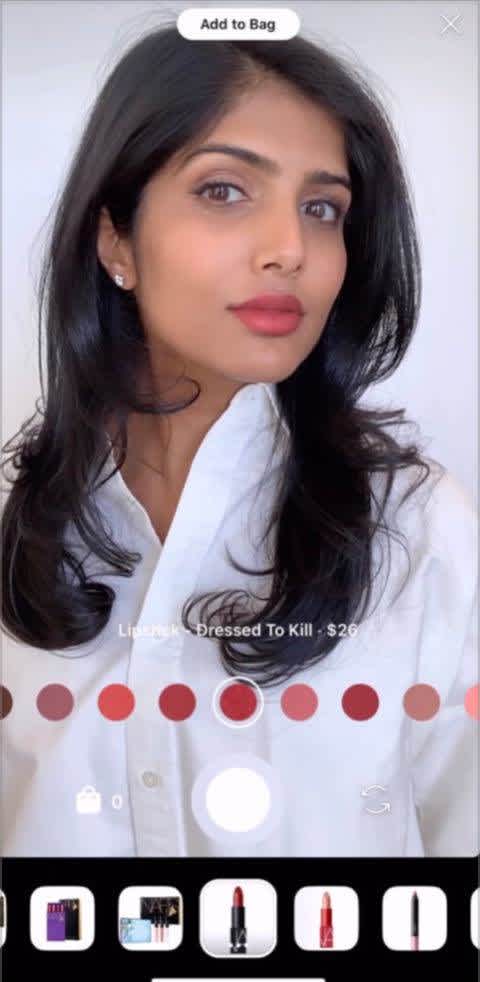
The feature is currently being tested with just a few brands, including Warby Parker and Ray-Bans, but we’re hoping they open it up to more brands in the near future!
Of course, your goal with AR doesn’t necessarily have to be about sales! Businesses also have a lot to gain from simply sharing creative and engaging AR effects that people like to use.
Take Adidas, for example. With vintage filters and retro-looking photos trending big this year, Adidas Originals decided to create a custom AR effect that adds a nostalgic VHS look to your stories, including a “glitch” effect.
This custom AR effect is super shareable and very on-trend, so it’s perfect for building brand awareness!
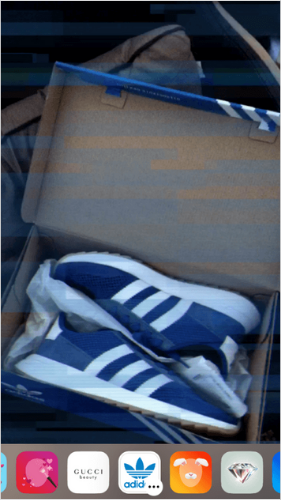
Instagram used to have a unique system for locking filters (you had to follow the creator first). As a result, many of the designers who were part of Spark AR’s beta program gained tens of thousands of followers after sharing their custom filters on Instagram Stories.
The process for unlocking custom AR effects is slightly different now — especially now that Instagram has introduced their new Effects Gallery, which makes it easier to discover unique filters from the creator community!
Now when you visit a creator’s profile, you’ll find a new effects tab above their feed where you can browse (and access) all of the AR effects they created. We’ll explain more about this below!
Here are some other ways that businesses can use Spark AR Studio to create branded experiences on Instagram Stories:
#1: AR Effects for Online Shopping
As successful as Instagram has been in creating a shopping environment on Instagram (including some new shopping features coming in 2019), some products just can’t be adequately described with photos or video.
Take Kylie Cosmetics. And early adopter of AR on Instagram, when you select Kylie Cosmetic’s AR effect on Instagram Stories, you can “try on” different lipsticks from Kylie’s Lip Kits (like Candy K and Glitz) to see which shade best suits your skin tone before making a purchase.
This is a perfect example of how businesses can use custom AR effects on Instagram. Not only are Kylie’s filters fun to use, but they’re also low-key promotional and super helpful if you’re actually looking to purchase the product.
One brand that’s already made some noise with AR is streetwear label Off-White. Ahead of last year’s Paris Fashion Week, Off-White rolled out an effect that allowed users to “try on” sunglasses from their collection, as well as adding other effects, like Off-White’s famous branded quotation marks.
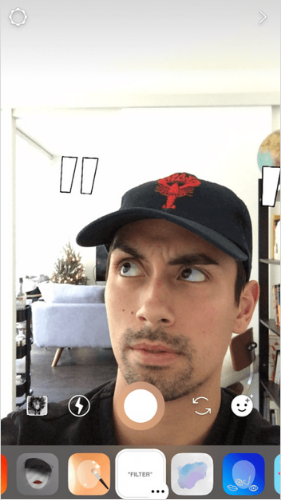
#2: AR Effects for Publishers
Like ecommerce brands, publishers have a lot to gain from creating their own AR effects for Instagram — and we’re already seeing some do it!
Take Buzzfeed Tasty for example. The ultra-popular food channel jumped into the AR arena last year, creating their own branded effect for Instagram Stories. When you select the effect, the slogan “Oh Yes!” floats and twirls on your screen.

What’s great about this effect is that it can be used in multiple contexts. For example, if you’re sharing a photo or video of a meal you made, you can use it to give yourself funny self-congratulations.
But you don’t even have to use it for food — it’s generic enough to fit all kinds of cases (this is actually one of the best practices we’ll discuss a little later in this post)!
#3: AR Effects for Causes
Last year, Rihanna created her own sparkly AR effect to promote the Diamond Ball and Clara Lionel Foundation. When selected, the effect adds a diamond headpiece to your selfie.
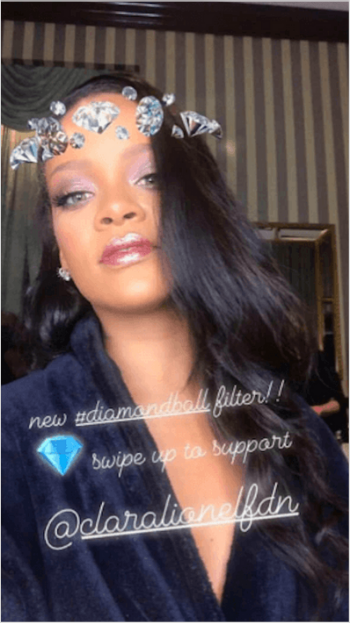
This is a great example of how businesses can use AR effects to raise awareness for causes they and their audience care about.
For example, an eco-friendly cleaning supply company could create an AR effect for Earth Day or another environmental holiday. Likewise, a fashion brand like Levi’s that supports water conservation could create an effect that sheds light on the issue.
Ready to jump in and create your own Instagram Stories filter for your brand? Check out our guide to help you get started with Spark AR Studio!
How to Access Custom Filters on Instagram
There have been some big changes to how users can find, try and explore new AR filters and effects on Instagram.
As we mentioned above, prior to the update, the only way to find and access custom AR filters was by following the creator on Instagram. Once you did that, their filters would appear at the bottom of your effects tray in the Instagram Stories camera.
Instagram’s new profile layout for AR filter creators simplifies this process a lot! Now when you visit a creator’s profile, you’ll find a new effects tab above their feed where you can browse all of the AR effects they created.
When you tap on an effect, you’ll have the option to “Try it.”
Tapping this button will open your Instagram Stories camera where you can try an effect right away.
You can also save your favorite AR effects by tapping the “save” icon in the lower right-hand corner of the effect:
When you do this, the effect will appear in your effects tray in the Instagram Stories camera — so you can quickly add it to any future stories!
In other words, you no longer need to follow a creator in order to access their AR effects!
You can also tap the “Browse More Effects” button to open Effects Gallery (you can also access Effects Gallery by tapping the ellipsis button on the previous screen).
Within Effects Gallery, you’ll find thousands of custom AR effects — plus the ability to sort by category or topic! For example, if you open the “Moods” channel in Effects Gallery, you can browse any AR effect that falls under that category.
Or you can open the “Color & Lights” channel to browse AR effects that play with lighting.
The Effects Gallery also features a feed of selected effects from Instagram’s creator community — it’s a bit like browsing posts on the Instagram Explore page.
Although you no longer have to follow a creator to access their effects (which was an incredible driver of new followers!), AR effects are still a great way to advertise your brand.
Whenever someone uses one of your AR effects on Instagram, they’re essentially promoting it (and you) to their followers, so it’s possible to create a snowball effect and even go viral!
How to Create Your Own Instagram Stories Filters with Spark AR Studio
As we already mentioned, Spark AR Studio is now in open beta, so brands, creators, influencers — really, anyone — can start creating their own custom AR effects for Instagram Stories.
And while it may sound intimidating, Spark AR Studio is designed for anyone of any skill level to express themselves, regardless of your technical background.
All you have to do is download the Spark AR Studio program and you can immediately get started building your own AR effects for Instagram Stories.
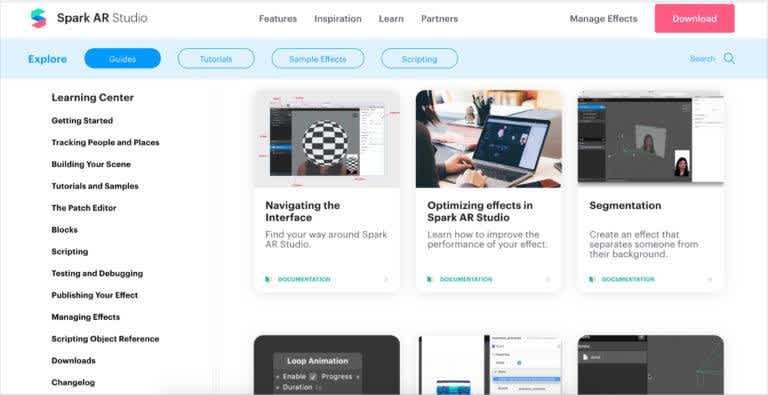
Plus, you don’t even need to know how to code to get started with Spark AR Studio.
If you’re completely new to the world of graphic design, start by learning the basics with the Spark AR resources page and watching their tutorials.
From there, you can start to navigate the tool — while it’s pretty intuitive for designing, even for those of us with limited tech backgrounds, you can get creative with your AR effects for Instagram with trial and error!
Facebook also provides a ton of documentation and guides that covers not only how to build your own AR effects (including textures, objects, face filters, games, and more), but also explains the approval process and how to submit your effects to be published.
Spark AR’s creative community is also buzzing with designers that are eager to help — so if you run into any problems, you can definitely submit a question in the Facebook Group.
But what if you don’t have the time or ability to create your own AR effects?
Well, another option is to hire a designer to create your AR effect for you! For this, we also recommend checking out the Spark AR creative community. There are tons of designers on there who have experience building AR experiences, so it’s a good place to start out.
The Spark AR Studio website also has a partners page with a big list of augmented reality producers, creators, and agencies.
You can also check out Lenlist, a website that compiles the top camera effects (and effects creators) for Facebook, Instagram, and Snapchat.
Even some *super* popular effects creators like Allan Berger and Tomas Posse offer services to create AR effects for brands and influencers!
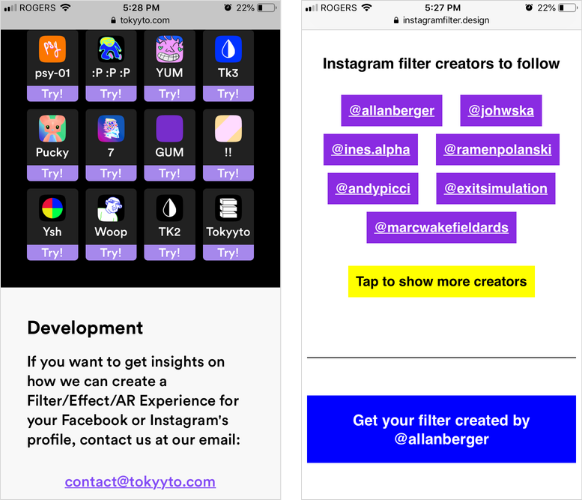
After creating an AR effect, you can then publish it to your Instagram profile or share it on a story. When your followers see the effect, they’ll be able to select it and use it in their stories.
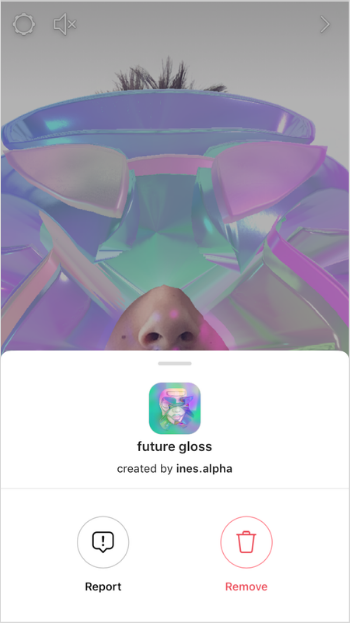
Each third-party-created AR effect will say who the creator is at the bottom, so the original account will still get all the credit (and hopefully a few extra followers too!).
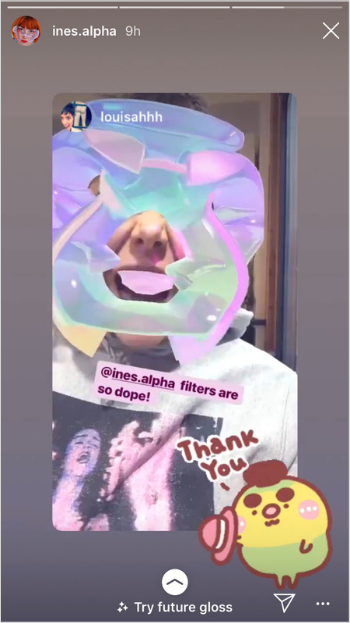
Want to learn more about creating your own Instagram Stories filter or effect with Spark AR Studio? Check out our blog post here!
Best Practices for AR Effects on Instagram
AR effects can be a powerful tool for businesses when used properly — but they also require a lot of thought and planning.
Here are some best practices to follow when creating AR effects for Instagram, according to Cemre Gungor, product manager on Instagram’s camera team:
#1: Serve a real need
AR Effects can serve all kinds of needs, whether that’s helping people learn about a product or simply making people laugh. Here are a few key ones:
Help people express their aesthetic: Instagram is a visual medium and people want to share their personal aesthetic and creativity. Many successful effects (like @johwska‘s Beauty3000 for example) help people elevate their photos and videos with colors, lights, or visual design.
Help people capture what they’re feeling, thinking, or doing: Sometimes photos and videos aren’t enough to capture what people want to share. Effects can help amplify someone’s emotions and perspectives when they’re sharing. People on Instagram especially love sharing what they’re into, whether it’s fitness, food, or even slime! Effects that “facilitate expression” tend to do really well.
Help people get inspired and have fun: People sometimes want to share with their friends but don’t know exactly what to say. An effect can help give people inspiration and create an interesting story even when nothing particularly interesting is happening around them.Help people make their friends laugh: Effects can be a great way to add humor to everyday settings and this can help people forge a connection with the people who are watching their stories.
Help people be part of something bigger than themselves: Many people share on Instagram to celebrate a cultural moment, support a cause, or to express admiration for someone or something. Helping facilitate these kinds of moments is a great way to build an engaged audience around your effects!
#2: Get out of the way
Commonly, the most successful effects on Instagram are re-usable — as in people can (and want to) use them over and over again. For this to happen, an AR effect needs to get out of the way and make people’s content the hero as opposed to making the effect the center of attention.
When you do this well, people can create something entirely new every time they use your effect!
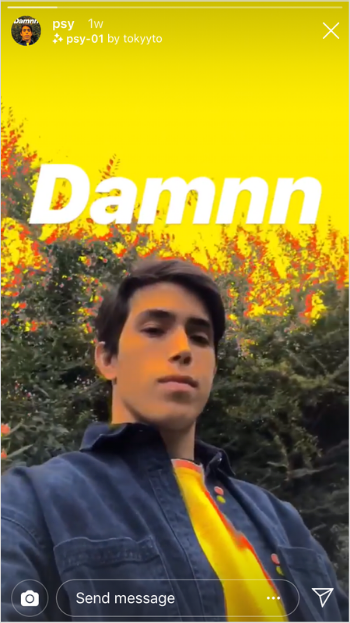
#3: Keep branding to a minimum
Branded effects that really resonate with Instagram’s community feel more like “gifts” instead of branded ads that drive specific business objectives.
So while branded effects can help people feel more connected to the businesses they support, it’s important to pick and choose which brand elements you include in your AR effects.
For example, while you probably shouldn’t include your logo, you can use things like branded colors, visual design, products, or mascots.
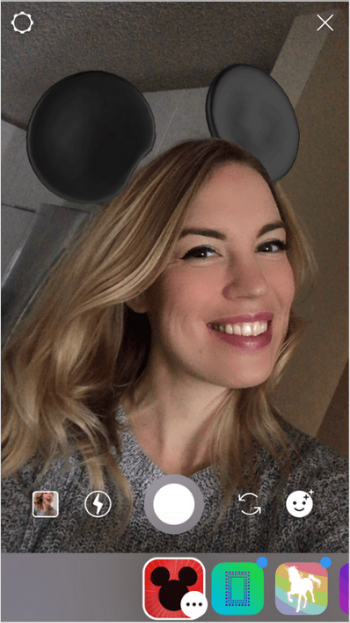
The reason you should think of your branded effects as gifts, not ads, is because Facebook found that Instagram users (especially younger users) aren’t fans of effects that have heavy branding elements in them.
#4: Make it easy and fun
It only takes a few seconds for someone to decide if they’re going to use your filter or not. So you should make sure that you get to the point right away!
One way to do this is to make effects that work with both the front-facing and back-facing camera.

You should also consider creating effects that work when there’s more than one person on the screen!
#5: Think outside the box
One of the principles above is to get out of the way and let people’s content be the hero. While this is certainly true for effects that get a lot of repeat use. But according to Güngör, Facebook has also seen a lot of examples of effects that “don’t lend themselves to repeat use,” but are still extremely shareable because they’re novel and fun.
Using Spark AR Studio for business can be a great way to connect with customers, build awareness, and even go viral on Instagram!
Whether you’ve decided to create your own AR filter for your brand or incorporate some cool existing AR effects into your stories posts, it’s a great way to grow your account.
The future is filtered so there’s no time like the present to jump on board the trend!
Learn how to grow your business and stay engaged with your followers using Instagram Stories with our free Instagram Stories Course!
